Hooray For Baja’s Bay Of LA
The following appears in the July issue of California Sportsman:
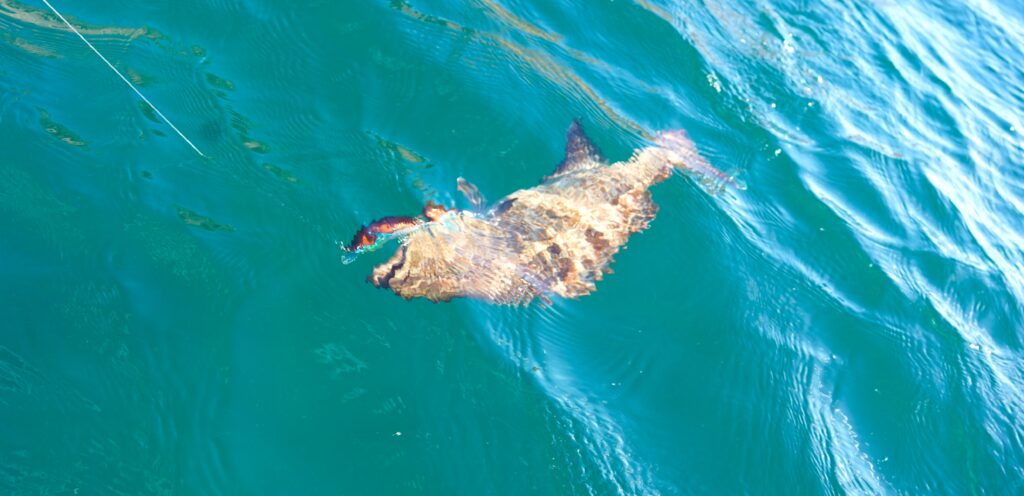
By Joe Sarmiento
Mexico’s Bahia de Los Angeles, or Bay of LA, is located on the Sea of Cortez side of Baja California, about a two- hour drive south from San Felipe on Mexican Federal Highway 5.
When I first moved to Baja California in April 2021, I was excited to experience firsthand all the various fishing destinations I’d only heard about from other anglers on the sportfishing boats of Southern California.
I’ve now had the opportunity to visit and fish them and for me, at the top of the list is Bahia de Los Angeles.
I’ve been to BOLA a handful of times now, and I was especially looking forward to my most recent trip there. I was in Gonzaga Bay fishing with Captain George Catian and my friend Dennis Leung in March of this year.
George is a young, talented pangero out of San Quintin who led us on a memorable Gonzaga trip last year. Another group of anglers were staying next to us and going out with Captain Juan Cook.
Juan is in his 70s and is
kind of a living legend. Like George, Juan is based out of San Quintin, but he likes to take his Parker boat to other Baja destinations as the fishing bite heats up at one spot or another. Juan came by to share dinner with all of us, giving me an opportunity to meet him for the first time.
I’ve followed Juan’s exploits on social media for a while. I admire how he does well on the target gamefish du jour, yet somehow always finds a way to catch something exotic or put a different spin on things. I was excited to finally meet him in person. I was thrilled when he invited me to join him as he brought his boat down from Gonzaga to BOLA in late May. When he extended this invite, I assumed he would trailer his boat down. He clarified that his intention was to drive the boat down on the water and fish all along the way. Yes, please – count me in!
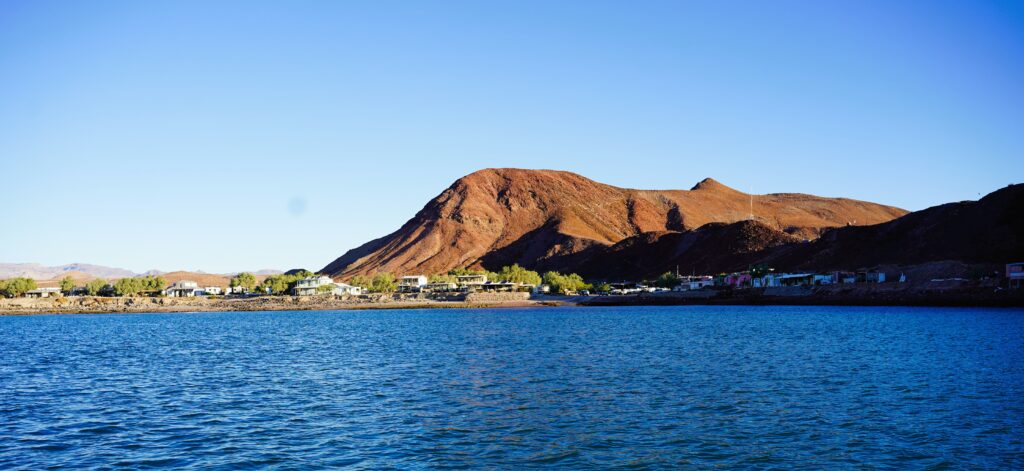
I DROVE FROM MY place in Rosarito Beach – 20 minutes south of the border – on the Pacific side of the Baja Peninsula, east to Mexicali, where I picked up the highway south to San Felipe. I stopped there to gas up and refuel myself with various seafood tacos (the spicy garlic octopus tacos are a favorite!).
Part of the allure in going to these places for me is how remote and primitive they feel. About 30 minutes south of San Felipe, you lose cell coverage. Becoming untethered to your phone gives you time to contemplate the experience ahead and imagine how it must have felt seeing the turquoise-blue waters of the Sea of Cortez for the first travelers there.
A couple hours later, I arrived in Gonzaga Bay. I stayed at the Papa Fernandez campo that night prior to our departure. Juan met me there the following morning to launch the boat.
The game plan for the drive down would be to hug the coastline and target leopard grouper – aka cabrilla – all the way.
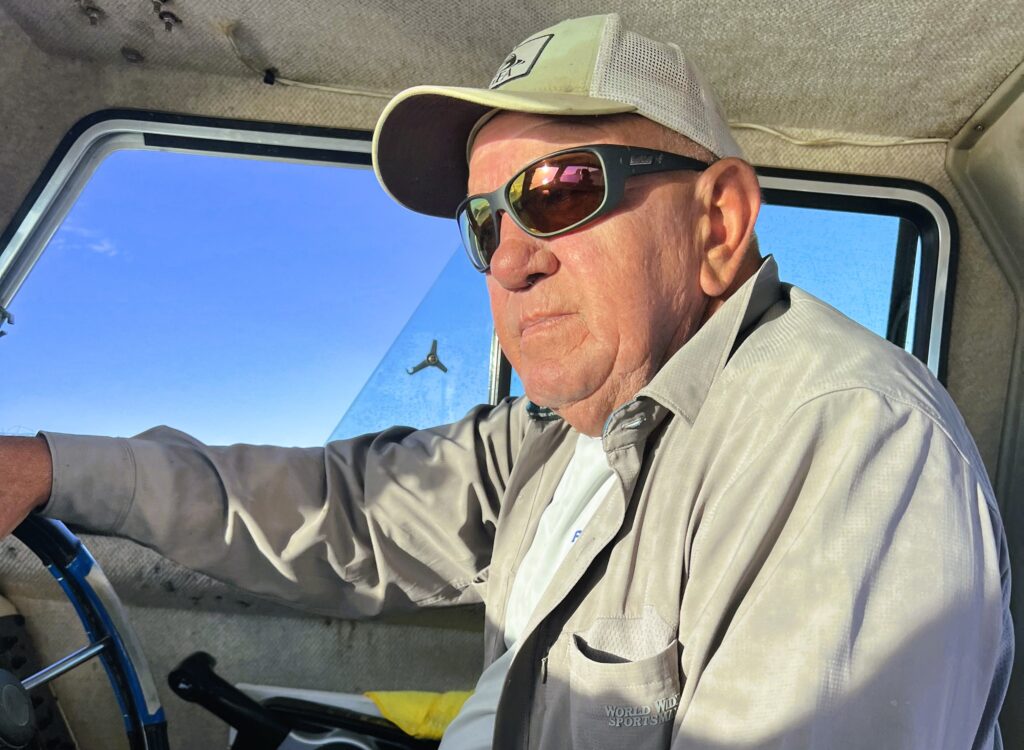
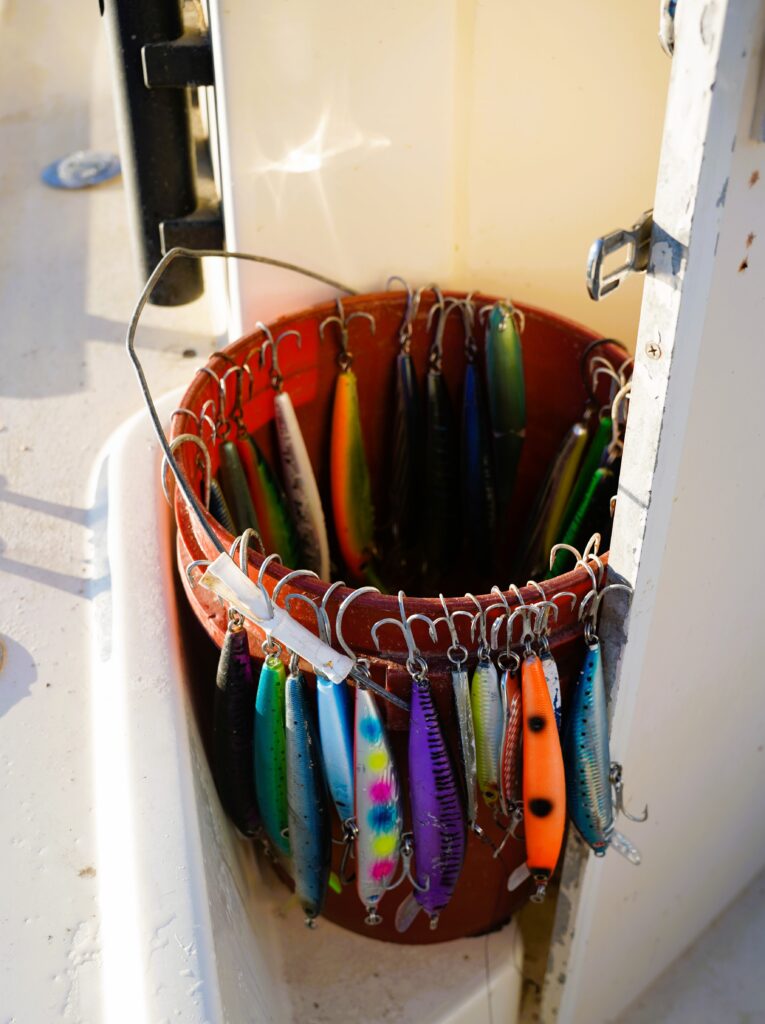
I’M OFTEN ASKED WHAT my favorite kind of fishing is, and targeting cabrilla is top of the list. If the water gets too warm, cabrilla will head to cooler, deeper water. You can catch them under these conditions using vertical jigs or dropper loop baits. That’s not the style of cabrilla fishing I long to do, though. I like it when they’re up in shallow and rocky structure to ambush unsuspecting prey that may wander above their target hunting area. These cabrilla are ferocious. They come up hard to strike their prey, then want to immediately return to their rocky lair below.
That behavior creates a special challenge to successfully getting them in the boat. You must fish heavy and lock down your drags. You will lose some cabrilla angling in this manner, but they aren’t finessable. You’ll lose every one fishing too light or thinking you can let them run and tire them out. It’s power fishing. You’re either going to win or lose each encounter, which is thrilling either way the outcome shakes out.
I had done this kind of cabrilla fishing on previous trips to Bahia de Los Angeles, but I was about to experience the next level of it.

The giant fish-stealing sea lions on this island were watching intently to see what was happening. (JOE SARMIENTO
KNOWING WHAT JUAN HAD in mind prior to the trip, I kept things simple in terms of what gear I packed. I brought my surface iron setup (Fishing Syndicate S-glass 90J rod paired with a Shimano Tranx 500 HG reel) because I have caught these fish on surface iron, but more so because if a spot of yellowtail were to pop up under birds, then I’d have the proper response to it.
My second setup was a custom Fishing Syndicate FSC 900L spinning rod, paired with a 13 Fishing Architect 4.0 reel. I’d put together this combo in hopes of fulfilling my goal of catching a yellowtail from shore this year. The Architect has 22 pounds of drag. I wanted to stress test this combo on cabrilla to see if it would be up to the challenge.
Finally, I brought a Fishing Syndicate FSC Inshore 900L rod, paired with a Daiwa Lexa 400HS baitcaster reel. This is the “proper” setup for this kind of cabrilla fishing – light so you can cast all day, but powerful enough to go mano a mano with these fish. I brought it just in case the spinning combo didn’t work out.
If there was any vertical fishing to be done, I figured I’d use one of Juan’s slow pitch jigging combos, as I’ve had a curiosity about fishing this way for a while and it is a specialty of Juan’s.
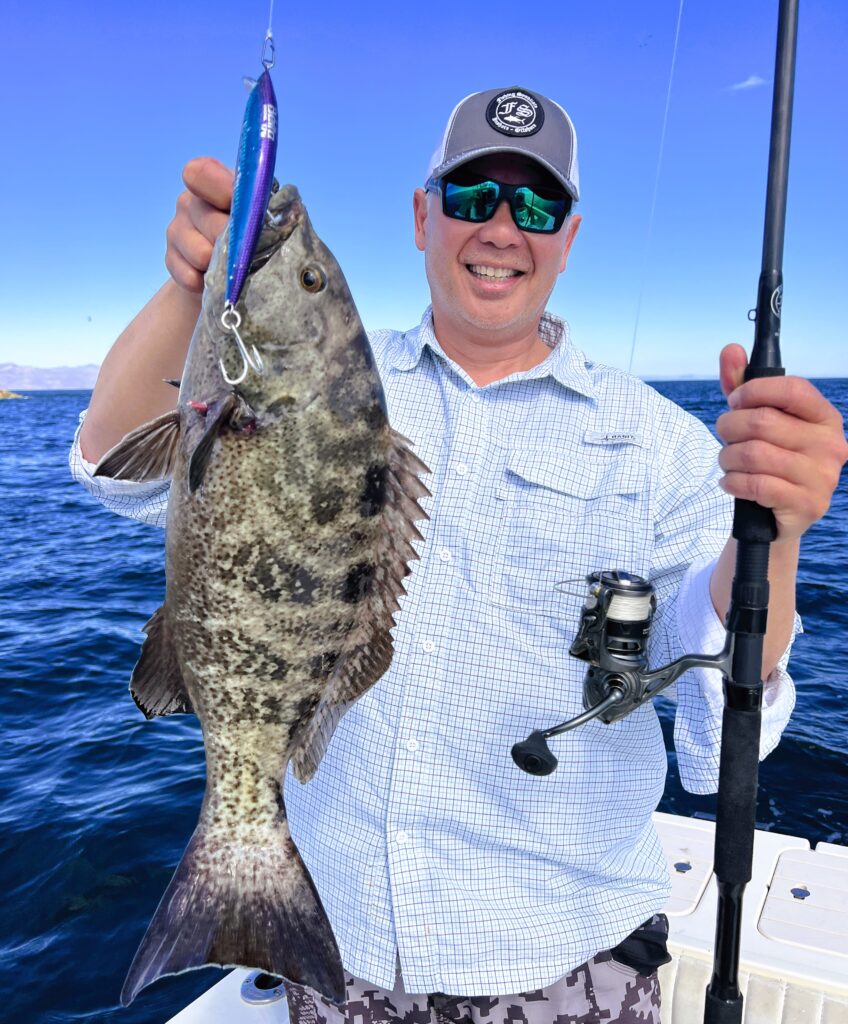
AFTER DEPARTING FROM PAPA Fernandez, we headed to Punta Final on the south end of Gonzaga Bay. I got my first glimpse here of how Juan thinks outside the box. There were a couple high spots just off the shore where the underwater terrain rises from about 95 feet to 40 feet. Juan knows there are fish lurking on these high spots, but instead of trying to jig for them, he recently started to troll for them. Using a Rapala X-Rap Magnum 40 deep- diving lure and trolling at a speed of 7.5 knots, Juan is able to present the lure in the target zone. He had been successfully employing this method before I arrived, but we only had modest success, with one cabrilla and a small yellowtail. Maybe it was just the day, or perhaps some commercial fishermen got to them. We moved on.
Prior to the trip, I’d been doing some online shopping to put together lures that I thought would be appropriate for this trip. As it turned out, I only brought one, a Yo-Zuri Hydro Minnow LC 170F, which fit the bill for what Juan preferred, a bigger profile bait with a lip to be a shallow diver. I managed to catch one fish using this lure and my spinning combo before I lost it. After I lost that lure – I kicked myself for leaving the backup at home – I borrowed from Juan’s bucket of favorite cabrilla lures.
As we made our way down the coast, it became increasingly clear that it just wasn’t going to be our day. Juan took me to some of his go-to spots, but they just didn’t produce. By my relatively inexperienced eye, conditions looked good. The spots felt like they should be holding fish. But if there were fish there, they didn’t want what we were offering.
As the day wore on, the hot wind blowing down from the surrounding mountains picked up. We kept hoping that just around the next point we’d find shelter from the wind and fish that wanted to bite. It didn’t happen. At least we made it safely to Bahia de Los Angeles. And there was another day left of fishing.
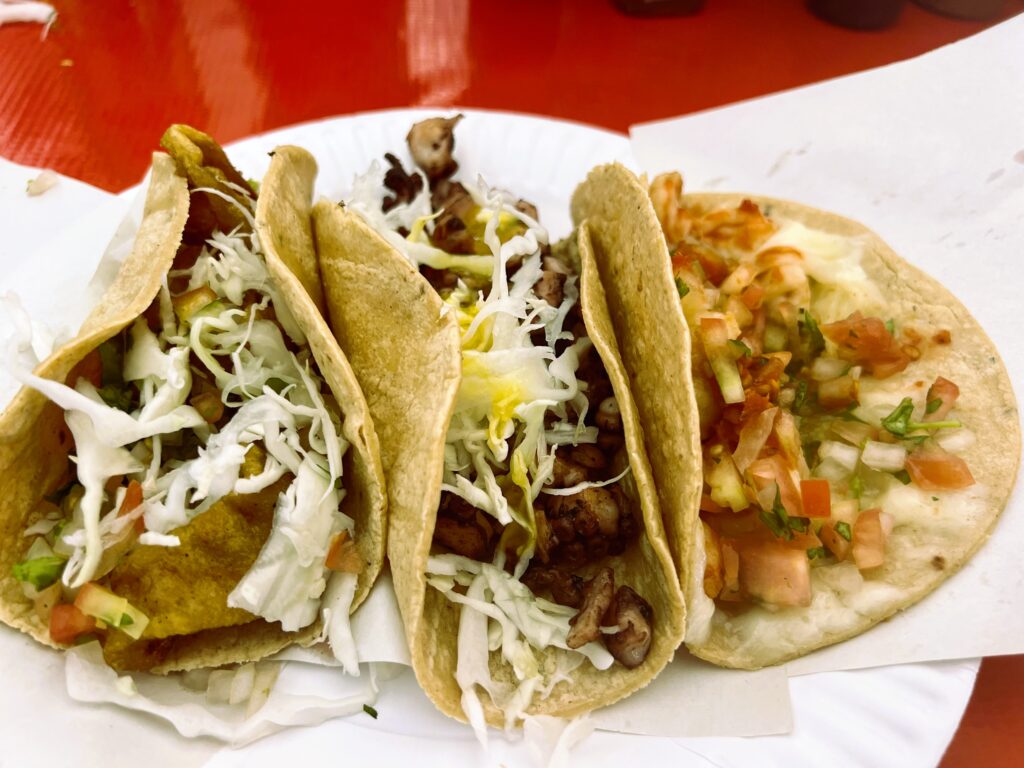
IN ALL MY PREVIOUS Bay of LA trips, we started our mornings making bait near the launch ramp area. But we didn’t need to make bait for day two because deep dropper loop fishing with live bait wasn’t part of our program. Beyond the parameters of our trip, though, Juan isn’t about using bait.
It was exciting knowing that the hour or two normally spent making bait would be added back to our fishing day. Juan warned me, though, that we had a long drive ahead to get where we wanted to be. We wouldn’t be stopping on birds working the waters or even boiling fish.
Along the way down, we saw a couple spots of birds. One even had fish boiling underneath. Despite these obvious signs of fish, we pressed on. It ran counter to my deeply ingrained fishing instincts, but I trusted Juan and didn’t say anything.
There was a bit of chop when we left the bay. We hugged the coast to moderate the drag on the boat. Isla Ángel De La Guarda loomed large on the port horizon. By the time we hit the far south end of the island, the chop miraculously cleared away. We were free to cross the channel. Juan wanted to fish the various small islands – they were really just rocky outcroppings – found just past the south end of the big island. I’d never ventured this far south and was excited to cast into these new waters. My enthusiasm was bolstered when I scored at the first stop.
As the day progressed, conditions only got better. The action was fast and furious. I had borrowed one of Juan’s lures that looked basically new when I tied it on. The cabrilla loved it and it quickly lost its new-lure luster.
The hottest action of the day was next to a tiny island loaded with sea lions, including a couple 600- to 800-pound behemoth bulls. It made me nervous. Usually, as anglers we try to avoid these fish-stealing mammals. Juan told me that cabrilla live alongside sea lions and the sea lions leave them alone. Pretty awesome if true, but I was skeptical. I would soon get the opportunity to test Juan’s statement.
I hooked up and two sea lions were right by my line. They put up a half-hearted chase and I got my fish into the boat. I hooked up again. This time it was a nicer fish. It actually pulled drag after my line came tight. I got some line back, but the fish was strong and still pulling hard. My rod was completely bent. I was locked in a stalemate with it.
I tried to turn the handle on my reel and I torqued on it so hard that the handle busted away from the housing that screws it into the reel body. Wow! Good thing I’d brought a backup. The Lexa 400 is loaded with 65-pound braid. When I retied, Juan recommended bumping up to an 80-pound fluorocarbon leader. I didn’t question it. These fish were mean and the terrain rocky.
While I was getting set up, Juan continued to fish. He scored a couple more and I stopped to snap a couple pictures.
When I was ready, Juan set up another drift. I took a couple casts to get used to the new setup. I quickly acclimated and started hitting my spots. It didn’t take long before I hooked into another good one. Keep in mind that I bumped my leader up from 60-pound to 80-pound test. Drag is fully locked down on a reel with 25 pounds of drag. I got smoked. I’ve only felt helpless on a fish a handful of times ever, and it had just happened again.
“What was that, Juan? A gulf grouper?” No; it was still a cabrilla, but probably one over 20 pounds. I was awestruck.
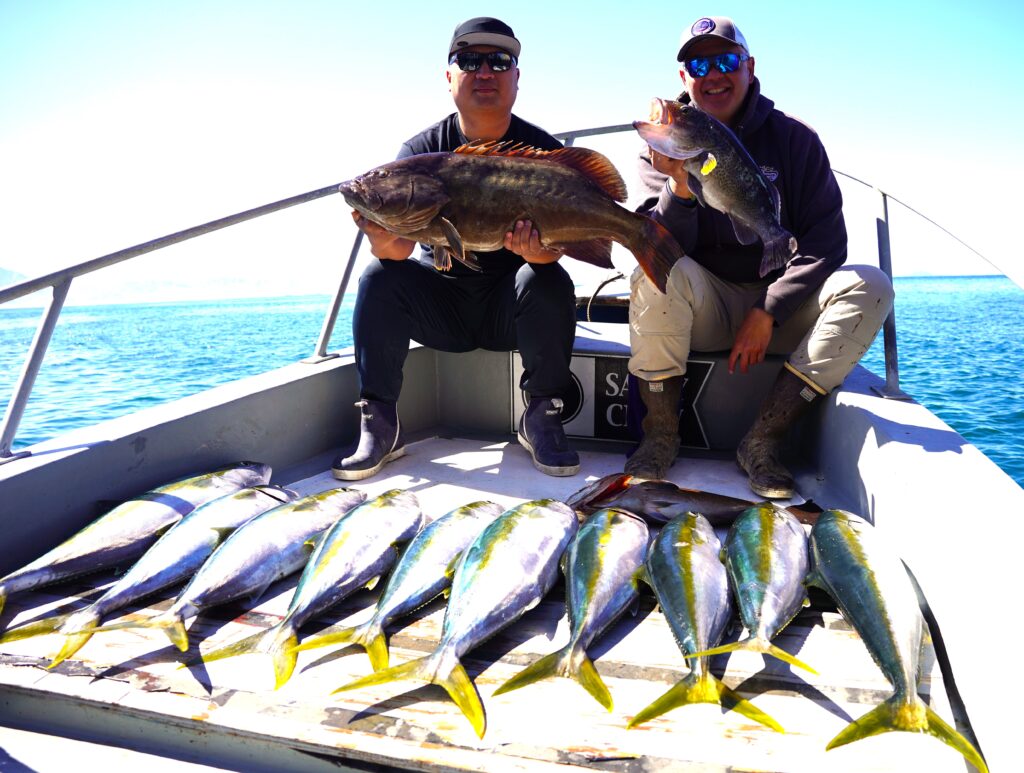
Dennis Leung and the author with a Gonzaga Bay haul caught in March. Moving to the Baja Peninsula has provided Sarmiento with some fantastic fishing options. (JOE SARMIENTO)
WE WERE OVER OUR allotted time and Juan wanted to start heading back. It seemed appropriate to end on that note – and left room to ponder how to be even better prepared on the next visit.
We packed up and pointed north toward home. Once we got back in the channel, though, we happened upon a massive spot of birds diving on bait. I gave Juan a pleading look. “C’mon, man, give me a shot.”
Maybe he felt bad that I had lost that last fish, so he gunned it to speed up to the spot. On approach, he killed the motor to slide into it. On the first cast on the surface iron, I put it just outside the spot of birds. A yellowtail follower chased my jig all the way back to the boat, but it didn’t bite. Juan spotted four free swimmers on his side of the boat. On cast two, I put it squarely into the middle of the melee. Wind. Wind. Hookup!
I wasn’t disappointed losing that cabrilla, but scoring a surface-iron yellow was the perfect end to the trip. I’ll never forget it. Thank you, Juan, and I can’t wait for the next time. CS
Editor’s note: For more information on Captain Juan Cook, go to facebook.com/ juan.cook.5680 and follow on Instagram (@captainjuancooksportfishing).



